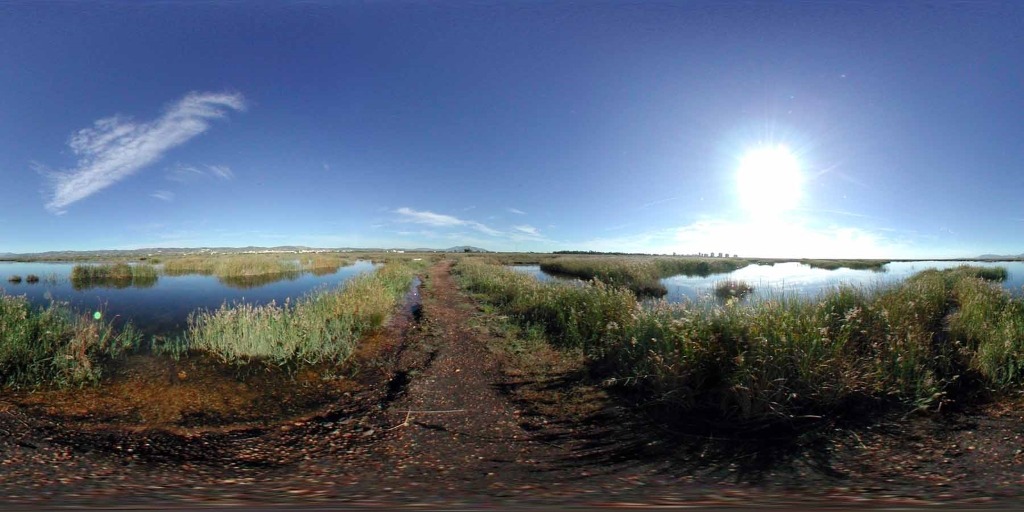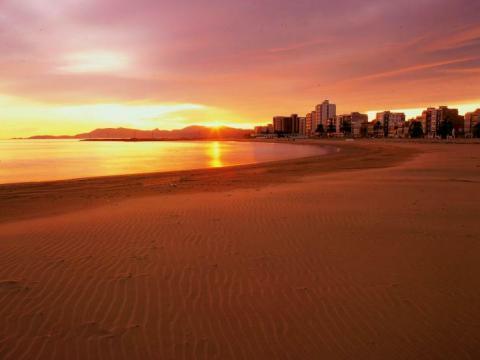Torreblanca, Comunidade Valenciana, Spain
Suggest Place to Visit
5101
Track to location with GPS |
 |
Torreblanca is a municipality in the Valencian Community, Spain. Located on the coast of the province of Castellón, in the Plana Alta region, between the municipalities of Oropesa and Alcocebre-Alcalá. It has 5,885 inhabitants (INE 2007). His first language is Valencian.
History [edit]
The demographic nucleus that over time, will receive the name of Torreblanca, was located, from the beginning, within the geo-historical enclave of Miravet, limited by the Sierra de Irta and the Cape of Oropesa.
The Romanization of this entire area is evident, since the Torreblanca coast was heavily visited by Roman ships. Regarding the discovery of finds, it is worth mentioning that 204 gold coins from the 1st and 11th centuries were found due to land clearing.
On April 27, 1225, Jose Luis Barrera de Aragón granted the bishop of Tortosa the castles of Miravet and Trini Cherta, with all its terms, farmhouses, farmhouses and churches. The castle of Miravet was a district made up of the fortress itself and included the neighboring castle of Albalat, the town of Cabanes and the places that would eventually become Benlloch and Torreblanca. The name ´´Torre de Luppricato´´ appears in this donation, which by reference and following the locations indicated, would eventually be the current Torreblanca.
The origin of its name, ´´Torreblanca´´, is the subject of controversy; According to the most widespread opinion, it was received by the location of the Torre del Marqués, a quadrangular, crenellated building, with defense loopholes and a barbican, carefully made in medieval times. It is assumed that he was inherited from Doña Blanca de Cardona, who could very well have been Doña Blanca de Aragón, daughter of the Infante Ramón Berenguer, and granddaughter, therefore, of Jaime II of Aragón. These data and references agree that Doña Blanca was able to name the ´´Torre´´ and this to the town. Some historians, however, hold the theory that the name of Torreblanca has its origin in the white walls of the Church-fortress of San Francisco.
Various historians have sought to locate the ´´Torre de Luppricato´´ and after interpreting the boundaries of the Miravet concession, the location of the Tower places it in the church-fortress of San Francisco: the thickness of its walls, the flush loopholes From the current ground, the ones that crown the building, the barbican and the voussoir door, prove its original defensive character and its antiquity.
Piracy became a way of life for both shores of the Mediterranean. In order to avoid surprises, the Christians of the kingdom of Valencia established a lookout service with fixed posts in towers or watchtowers and warning posts.
In 1397, the Berber pirates assaulted the town, taking jewels from the church and the Host consecrated with the Custody. When the news was known, the Council of the Kingdom agreed to organize an army that would punish the injury and recover the Sacred Forms, transferring the agreement to King D. Martín I of Aragon to favor the company. Even Benedict XIII issued the Bull for the crusade.
From Ibiza the army went to Telediç and, after the landing, the city was preyed upon by Christians for two days with it: burning, destruction, killing more than a thousand Muslims and taking about three hundred prisoners. The loot was large and the sacred forms and custody were recovered.
The fact of the bloody combat of Telediç would give rise to the legend of the appearance of a lion in the middle of the battle. Tradition says that the more fierce the battle was, a lion came down from the mountain, killing the one who had the Custody and reinstated it to the Christian captain. This tradition has been incorporated into heraldry: The rampant lions hold or grasp the Custody next to the bars of the house of Aragon, commemorating the conquest of the place by the hosts of Jaime I.
On August 30, 1576, the bishop of Tortosa granted charter populates 38 families to occupy houses and cultivate land, abandoned for more than a century. The growth of the town throughout the seventeenth century is constant and the council already has enough personality to litigate with Cabanes for firewood and hunting in El Prat, at the same time that it holds lawsuits for its herbace and fishing rights with Doña Blanca de Cardona, managing to mark their land. In the 18th century, he built a new Parish Church and built his house in La Vila. Already in 1896, Torreblanca requested from the government a jetty for its beach. It was one of the few towns that adheres to the creation of a union to defend orange production. He will form part of the commission of mayors who for the first time ask for the Ebro Canal. In 1935 he requested a tourist road between Peñíscola and Oropesa, as well as the construction of a fishing port, since they operate up to 120 trawlers and trams ´´. So many illusions or endeavors are falling into indifference and seafarers emigrate to Peñíscola or Grao de Castellón. Torrenostra is depopulating and only the determination of the town will make it reborn from the 60s of last century, with the resurgence of Torreblanca beach, ´´Torrenostra´´ as a tourist center.
Population 2,304 2,827 3,434 3,639 3,424 3,698 3,563 4,208 3,809 4,140 4,577 4,608 4,614 5,656 5,885
Economy [edit]
Traditionally based on agriculture, predominantly the cultivation of citrus fruits, and the consequent industry for handling them. There are also furniture factories and some farms. At present, the tourism sector has developed significantly on Torrenostra beach.
Monuments [edit]
Religious monuments [edit]
The Calvary. Calvary and primitive Church. It is one of the most interesting of the Castellón lands, preserved in its entirety and with few changes since its construction in the 18th century. The Chapel is simple, with a square plan and covered with a dome with its own light. The work is made of masonry with carved stone reinforcements in the corners and on the cover. Inside the Calvario enclosure is located the original fortress tower of ´´San Francisco´´.
Primitive Church of San Francisco. In the Calvary enclosure is the original church of the population, dedicated to San Francisco de Asís, and with a strong character of strength. Dating back to the 14th century, it has a single rectangular nave with diaphragmatic arches supported by pillars attached to it, the vault is ribbed with terceletes and ligatures.
Parish Church of San Bartolomé. Conceived by Juan Barceló in the 18th century. The temple consists of three naves, with four sections and side chapels. Noteworthy are the vaults with a transept dome covered with blue glazed tiles. The temple preserves inside valuable works such as El Salvador, by Josep Ferrer, or passages from the life of San Bartolomé, by Joaquín Oliet from Morella, in the dome. There is currently a 17th century canvas by José Orient on the Berber pirate assault of 1397.
Civil monuments [edit]
Tower of the Marquis. This tower belonged to Doña Blanca, a descendant of Jaime I, hence it was formerly called ´´Torre de Doña Blanca´´. It is a medieval building with a square plan, crenellated with a small arcade and an armored entrance door with thick nails. View image
Places of interest [edit]
El Prat natural park. Wetland area that houses various species of aquatic birds. With its enormous landscape value, it constitutes the largest and best preserved wetland in Castellón. The Prat Natural Park extends over an approximate area of 800 Ha., Belonging to the municipalities of Torreblanca and Cabanes. The landscape of El Prat is that of a coastal plain separated from the sea by a cordon of gravel and pebbles with accumulations of sandy deposits that constitute the marshes and swamps of the aforementioned Park. Its length is approximately 7 km, and 1.5 km wide, it served as a closure to an old lagoon, and behind this cord there is an area in which quaternary turbesa deposits appear, related to deltaic and coastal sediments .
The species that can be observed in this environment are the basket, the tern, which has here the only breeding point in the province of Castellón, and the plover plover. Among the birds of passage, species such as the black-footed tern, sandpiper and the oystercatcher should be highlighted.
From the faunistic point of view, the fartet and the samarugo, protected and endangered species, or the gambeta, inhabiting clean coastal waters, acquire great importance.
The ecological and scenic interest of this space, as well as its fragility are the reasons that have led to its conservation through the declaration of protected space.
Torrenostra. Just three kilometers from the town, this sandy beach is ideal to enjoy the sun and the sea. The clean waters, the security services, the playgrounds and other public facilities make it the perfect place for children and adults to spend the day. The maritime town of Torrenostra, connected by a straight road and with an excellent beach, is an old marine nucleus that today is in the process of growing development as a tourist and summer resort. It has one of the multiple Watch Towers that were deployed in the province of Castellón that has recently been restored and can be visited by faithfully recreating its nature and use.
North Beach.
Festivities [edit]
Festivities of San Antonio Abad and Santa Lucía. The town celebrates its traditional week of Fiestas in Honor of San Antonio Abad, on the 17th and Santa Lucía on January 18. The night before the delivery of the "Coqueta" typical pasta of the Holidays. During four or five days there is an exhibition of cattle in the morning and afternoon and ´´Toro Embolado´´ at night. The tasting of the ´´Pasteles de San Antonio´´ (Patissets de Sant Antoni) is typical.
Carnivals With the trial of King ´´Don Carnal´´ (Carnestoltes) parades and a great costume ball including spectacular prizes for the best costumes.
The Passion of Torreblanca. Premiered on April 12, 1979, it is held in its sole representation on Holy Thursday, at ten o'clock in the evening, in various outdoor natural settings. The dialogues are entirely in Valencian. The Passion of Torreblanca, consists of seventeen scenes and its approximate duration is two hours. Most of these, except for the Stations of the Cross and the final paintings of Calvary take place in the wide area of the town's Plaza Mayor.
Virgin of Carmen. Torrenostra, as a fishing village, celebrates the festivity in honor of the patron saint of fishermen on July 16 with a mass on the beach, bullfighting festivities and festivals.
Festivities. At the end of August Torreblanca celebrates its Major Festivities in honor of San Bartolomé, its Patron, and the Blessed Sacrament, alternating religious and popular acts with bullfighting celebrations of which its typical ´´Entrada´´ ´´Salida´´ (entrance and exit in the San Fermín style), its novilladas, exhibitions of cattle and ´´Toro Embolado´´ (Bou Embolat).
Gastronomy [edit]
The cuisine is based on seafood, vegetables from the fertile orchards of the coast and rice as a fundamental ingredient. In addition to the Valencian paella, the typical dishes of Torreblanca are: the ´´olla torreblanquina´´, the ´´stone of beans´´ and for dessert the ´´pasteles de San Antonio´´. ´´Membrillo´´, ´´Torta Cristina´´ and ´´Coca de almendra´´.
Comments
We don´t have yet any comments about:
White Tower
White Tower
Be the first to leave a comment as it is very important to inform other people
Outros locais a visitar
Within a radius of 20 km from:White Tower
Naturpark des Prat de Cabanes-Torreblanca |
| 4,8 Km |
 |
Parc Natural de la Serra d'Irta |
| 14,5 Km |
 |
Hotel reservation near White Tower within a radius of 20 km
Why to book with TOURISTISCHE ROUTEN
The best prices
Our partnerships with the world´s largest operators offer research on the best market prices.
More options
At Rotas Turisticos you can book the hotel, buy the air ticket, book the transfer from the airport to the hotel and vice versa, book the local excursions, rent the car, take travel insurance and consult the places to visit and where to go.
Holiday Tips & Destinations
Hundreds of holiday destinations with all the options that allow you to easily choose the destination that best suits your dream vacation.
TOURISTISCHE ROUTEN
Links






